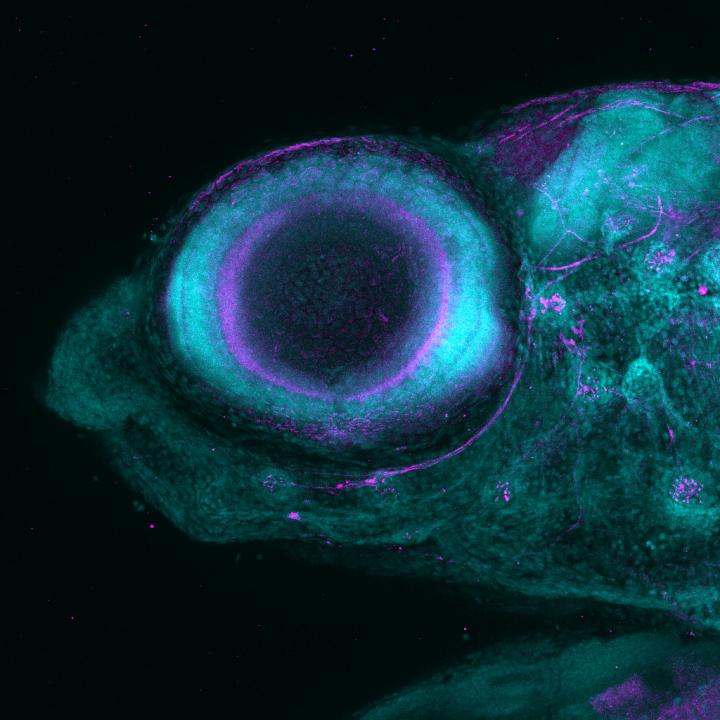Zebrafish's near 360 degree UV-vision knocks stripes off Google Street View

This is an image of eye of larval zebrafish under confocal microscope highlighting nerve cells. Credit: University of Sussex Usage Restrictions: To be used only in conjunction with reporting of press release.
A zebrafish view of the world has been forensically analysed by researchers at the University of Sussex to reveal that how they see their surroundings changes hugely depending on what direction they are looking.
The study of the colour vision system of zebrafish larvae, published today in Current Biology, reveals they use their near 360 degree view of their world to detect threatening silhouettes above them in black-and-white but can seek out the almost transparent single-cell organisms they feed on by detecting the scattering of light in UV.
Dr Tom Baden, a senior lecturer in neuroscience at the University of Sussex who led the research, said: “By measuring the activity of thousands of neurons in the live animal while presenting visual stimuli, we established that different parts of their retinas, looking at different parts of the visual world, do different things.
This multi-faceted view makes perfect sense for zebrafish as that's how colour is distributed in their natural habitat. In their natural visual world, most colour information is on the ground and the horizon but above them the objects of most interest are dark silhouettes, so colour vision here is rather pointless.”
The study is the first in-depth physiological description of any vertebrate's retinal setup for colour vision that uses “4 input colours” which includes a large proportion of non-mammal species such as most birds, reptiles, amphibians and fish. By comparison humans only use three and mice, dogs and horses only two.
The researchers say little is understood on how colour vision based on four or more spectral inputs works at a neuronal level but their paper, should help pave the way for further discoveries in this field. The team custom-built a hyperspectral scanner that allowed them to capture the full spectrum of light in the zebrafish natural world at each pixel including for UV vision.
The study found that zebrafish, who during larval and juvenile life stages live mostly in shallow, low current pockets on the sides of streams and rice paddies, only seem to use their colour vision repertoire for looking down and along the horizon, use colour-blind circuits for looking straight up and extremely sensitive ultraviolet vision for looking forward and upwards.
The zebrafish has made a supreme evolutionary effort to develop this superior vision, with about half of all its neurons inside the eyes making up nearly a quarter of their total body volume and requiring substantial metabolic investment. Similar ratios on a human being would mean eyes around the size of a large grapefruit which would require an optic nerve the width of an arm.
Dr Baden said: “Clearly, animals like zebrafish use specialised strategies to better navigate their natural environment by adjusting their eyes to look out for different things in different parts of their visual field. In contrast, technology has not really caught up with these types of ideas. For example, most standard camera systems still “blindly” use the same type of light detection and compression across an entire image even if half the image shows bright blue sky and the other half the overgrown and shadowed ground.”
Media Contact
More Information:
http://dx.doi.org/10.1016/j.cub.2018.04.075All latest news from the category: Life Sciences and Chemistry
Articles and reports from the Life Sciences and chemistry area deal with applied and basic research into modern biology, chemistry and human medicine.
Valuable information can be found on a range of life sciences fields including bacteriology, biochemistry, bionics, bioinformatics, biophysics, biotechnology, genetics, geobotany, human biology, marine biology, microbiology, molecular biology, cellular biology, zoology, bioinorganic chemistry, microchemistry and environmental chemistry.
Newest articles

NASA: Mystery of life’s handedness deepens
The mystery of why life uses molecules with specific orientations has deepened with a NASA-funded discovery that RNA — a key molecule thought to have potentially held the instructions for…

What are the effects of historic lithium mining on water quality?
Study reveals low levels of common contaminants but high levels of other elements in waters associated with an abandoned lithium mine. Lithium ore and mining waste from a historic lithium…

Quantum-inspired design boosts efficiency of heat-to-electricity conversion
Rice engineers take unconventional route to improving thermophotovoltaic systems. Researchers at Rice University have found a new way to improve a key element of thermophotovoltaic (TPV) systems, which convert heat…



